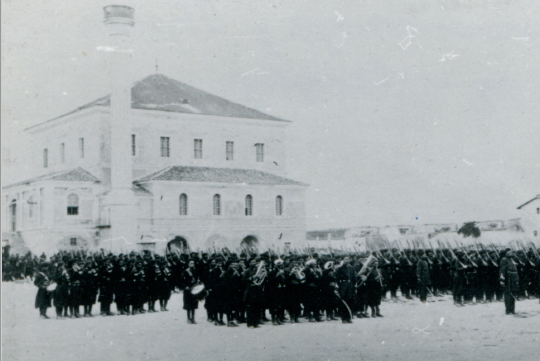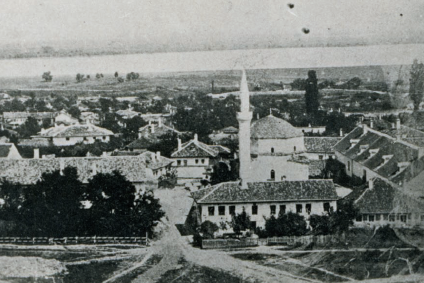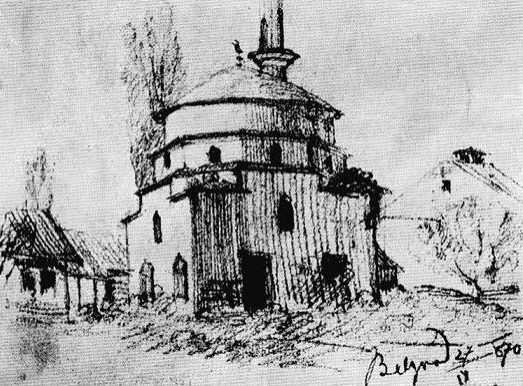During the third siege of Belgrade in 1521, Sultan Suleiman the Magnificent succeeded in conquering the then Hungarian city. Belgrade became an important Ottoman stronghold for further invasions in Europe. The city field by the fortress was named Kalemegdan by Ottomans (Kale - fortress, Megdan - field). The multi-century presence of Ottomans in Belgrade due to turbulent historical turmoil resulted in altered and mostly lost Ottoman heritage. The the part of town where the Turkish community lived is still called Dorćol and there we can still trace the remains of their heritage.
The Islamic places of worship that were built in Belgrade were: mosques, masjids and musallas. The mosque is a place for public prayer, to which the muezzin calls from the minaret - a high tower that rises next to the mosque. Masjids and mosques are prayer spaces, smaller in size, and without public gatherings.
The first mosques were created in the Lower Town of the Belgrade fortress, by remodeling Christian churches. According to the earliest Turkish document from 1536, the number of mahals/town districts was only four, as many as there were mosques. Already in 1571, the number of mahals was 21, but it is not known how many mosques there were. At the beginning of the 17th century, the number of mosques rose to 60. During the second Austrian siege of Belgrade, some mosques were destroyed, so according to the Austrian census from 1728, 17 mosques were found in Belgrade (and two more that were outside the fortified city). whose purpose was then changed.
Based on various sources and research, it is known that by the end of the 18th century there were up to 60 mosques and a smaller number of masjids. During the third Austrian siege of Belgrade in 1789-1791. a large number of mosques were demolished. In the First Serbian Uprising, the remaining mosques were converted into buildings for other purposes.According to an 1836 census, Belgrade was home to 16 mosques. Over time, all of them were demolished except for one, the Bajrakli mosque in Dorcol.
BATAL MOSQUE
BATAL MOSQUE
In the area of The National Assembly building, on the corner of Vlajkovićeva Street and Kralja Aleksandra Street, the Batal mosque stood tall. According to sources, this was one of the largest mosques in Belgrade. It was originally named after its founder, Einehan-beg, who built it around 1585. In the Austro-Turkish war in 1789, it was seriously damaged. Its name derives from the Turkish word batal which means neglected, therefore "Batal-mosque". It was demolished in 1869.
The external and internal appearance of the Batal mosque depict the drawings that have been preserved by Konsantin Jovanović. It can be seen that the openings of the mosque were finished with oriental broken arches. The interior was richly decorated with floral motifs and polychrome arrangement of stone blocks. The dome rose on trumpets decorated in a typical oriental style.

Konstantin Jovanović, Unutrašnjost Batal džamije, oko 1870. Zbirka za arhitekturu i urbanizam Muzeja grada Beograda
DEFTERDAR MOSQUE
It is known by various names, and it is assumed that it was built in the 18th century at the latest.
It was probably demolished soon after 1878. According to sources, it was located near Württemberg's barracks and next to the Protestant church. Based on these data and photographs that have been preserved, the Defterdar mosque was located on the corner of today's Vuka Karadžića and Obilićevo venac streets, where the "Proleće" tavern was later built.

I.V. Groman, Defterdarova džamija, između 1876. do 1878. godine (Izvor: SANU)
SULTAN MAHMUD MOSQUE
After the re-establishment of Ottoman rule in Belgrade, the Turkish Sultan Mahmud I (1730 - 1754) ordered the construction of a new imperial mosque in the Upper Town of Belgrade. It was located near Damad Ali Pasha's turbe, on the plateau of the Upper Town of the Belgrade Fortress near today's Clock Gate. Since it was in the immediate vicinity of the residence of the Belgrade pasha, it was in good condition. Within the mosque, there was also a library and a madrasa, an Islamic school.
When the Turks left the fortress in 1867, the mosque began to fall into disrepair. It still existed in 1876, when it was shown in a drawing by Nicolo Lazaro. After 1878, it was turned into a hospital and its minaret was destroyed. They say that later there was ammunition in it, which accidentally exploded and destroyed the mosque. It was finally demolished before 1895.

Anastas Jovanović, Džamija sultana Mahmuda, 1876. Istorijski arhiv Beograda
KIZLAR-AGA MOSQUE
The mosque, which was located on the corner of today's Braće Jugovića and Višnjićeva streets, below Studentski park, was built by Turgut-beg at the end of the 16th or the beginning of the 17th century. During the first Austrian siege of Belgrade in 1688, it was damaged like most other mosques, and during the second Austrian rule, it first became an artillery warehouse, and from 1726 to 1739 a Catholic church. In 1741, it was restored by Kizlar-aga, the elder of the harem. During the third Austrian siege between 1789 and 1791, it was converted into a Catholic church, and during the Serbian uprising into an Orthodox church. From 1813, it again functioned as a mosque. It was demolished in early 1878.

Anastas Jovanović, Kizlar -agina džamija, oko 1865. Istorijski arhiv Beograda
IMARET MOSQUE
According to historical sources, it was built by Jahjali gazi-Mehmed-pasha, Smederevo's Sandzakbeg in 1548/49. He was the brother of Bali-beg, the first Turkish governor of Belgrade. Historical documents mention that he had a hostel and an inn nearby. Imaret in Arabic means mosque, but in Turkish it also means inn, ie. in today’s sense folk cuisine. It was located in the block between today's streets Cara Dušana, Dubrovačka, and Knićaninova. It was demolished probably during 1878.

Konstantin Jovanović, Imaret džamija 1870. Muzej grada Beograda
ALI-PASHA'S MOSQUE
Some historians believe that there was a time when Evliya Çelebi in 1660 in Belgrade and and identify it with the Jin Ali-beg mosque.It was located in the area of the streets of Braće Baruh, Visoko Stefan, Cara Uroš and Despota Đurđa.

Lupa Peter, Ali-pašina džamija, 1858.
SULTAN MUSTAFA MOSQUE
When it was built in 1560, it served as a masjid (a small religious building), and from 1572 it was a mosque. Some sources indicate that this is Ferhad-cehaj's mosque. It is believed that it was destroyed or damaged during the Austrian siege in 1717, because the mosque of Sultan Mustafa appears in later sources. It was last mentioned in 1870. Today, it would be located on the very corner of Dušanova and Tadeuša Košćuškog Street.

Konstantin Jovanović, Unutrašnjost jedne džamije, oko 1870. Zbirka za arhitekturu i urbanizam Muzeja grada Beograda
BAJRAM-BEG MOSQUE
It was built between 1557 and 1560. It originated from the masjid dedicated to Bajram Bey, which was the Smederevo Sandzak Bey. A madrasa / school and turbe were formed next to the mosque, as well as the entire mahala / district that bore his name. It was located in today's Dositejeva Street between Simina and Gospodar Jevremova Street. During the second Austrian siege, it was converted into a Catholic church. It is not known exactly when it was demolished, probably in the 1870s.

Konstanstin Jovanović, Bajram-begova džamija 1870. Zbirka za arhitekturu i urbanizam Muzeja grada Beograda
LAZ-OGLIJE MOSQUE
It is not sure when it was built, but it is assumed that it was renovated after 1791. by Laz Oglije. It is mentioned in the list of mosques from 1836 and in the Turkish plan from 1863, but it is not mentioned in other documents from the 19th century. It is believed that it was demolished between 1863 and 1867 and that it was located in today's Strahinjića bana Street, between Višnjićeva and Kralja Petra.

Konstantin Jovanović, Ulica sa napuštenom džamijom,oko 1780. Zbirka za arhitekturu i urbanizam, Muzej grada Beograda
HASAN-PASHA MOSQUE
After the re-establishment of Ottoman rule in 1740, one of the first buildings built in the Lower Town of Belgrade was the mosque of Sheikh Hasan-effendi. It was damaged in 1806, later the minaret was demolished, and after the migration of the Turkish population, it began to decline, but it is not known when it was finally demolished. It was located on the outskirts of Riga od Fere and Gospodar Jovanove streets.

Hasan pašina džamija, Donji grad, 1865, Istrorijski arhiv Beograda
LAZ HAJJI MAHMUD MOSQUE
According to historical sources, the Laz Hajji-Mahmud Mosque was built after 1740 at the latest. It was drawn in the plan from 1789, and the street next to it was marked as the "street of the new mosque" (Neue Moschee Gassen). It was last mentioned in 1865 in the lists of Turkish estates in Belgrade. It was located on today's corner of Čika-Ljubina and Zmaj-Jovina streets.
According to the drawings of Belgrade that are in the National Museum in Budapest,it shows a rectangular building with a quadrangular roof, a minaret and a porch on all 4 sides of the building.

Džamija Laz Hadži-Mahmuda (Izvor: M.Dželebdžić, Zanimljivi crteži nekih beogradskih građevina u odeljenju istorijskih planova Narodnog muzeja u Budimpešti. Godišnjak grada Beograda,1974.)
SULEJMAN'S MOSQUE IN THE UPPER TOWN OF BELGRADE
According to sources, during the Ottoman rule, there were three mosques of Sultan Suleiman the Magnificent in Belgrade. The largest and most beautiful of them was located near the Defterdar gate, above the fountain of Mehmed-pasha Sokolović.
The Turkish travel writer Evliya Celebi was the first to describe it, talking about the magnificent appearance of the mosque, which, as he states, was designed by the famous builder Suleiman Sinan.
The mosque is mentioned in a Turkish document from 1630, where it is called the Emperor, and according to the plan from 1663, it is the only mosque in the Upper Town of Belgrade.
It is not known when exactly it disappeared. During the thorough reconstruction of the fortress 1720-1736. that part of the upper town plateau was lowered by the Austrians by a few meters and leveled to today's level. On that occasion, the foundations of the mosque were "excavated", so that today it is not possible to say where exactly it was located.
EMPEROR'S MOSQUE
The Emperor's Mosque on the Sava river was first mentioned in 1560 as a mosque in the Skala neighborhood, in the port. It is mentioned in the 19th century as a mosque on the Liman, and in the list of mosques from 1836, its name, Sheriff Mosque, is mentioned for the last time. The list states that there is no minaret and that prior to that it was "Mula Mehmedova's tavern".
It was located around the corner of Karađorđeva and Braće Krsmanović streets, and it has not been determined exactly when it was demolished.
According to historical sources, after the events at Čukur-česma in 1862, when a conflict between Turks and Serbs escalated, the Turks fled with their wives and children to the mosque on Liman. It is believed that the mosque on Liman was exactly on the site of today's supporting pillar of Branko's bridge, on the right bank of the Sava river. The King Alexander Bridge was built in 1934, and demolished in 1941, and in its place today is Branko's Bridge.
REIS-EFENDIJA MOSQUE
It is assumed that it is a mosque founded by Ahmet-aga Malkoci, a Turkish commander. The mosque was restored by Reis-effendi Haji-Mustafa in 1739/1740. and since then it has been called the Reis-effendi mosque. It was located in the block between Cara Dušana, Dubrovačka, Skender-begova and Cara Uroš streets.
FAKIR HAJJI-ALI'S MOSQUE (Fukara Mosque)
The mosque was built between 1650 and 1652, and has been rebuilt several times throughout history, and was finally demolished in the 7th decade of the 19th century. Its location covers the block between today's streets Tadeuša Košćuška, Solunska and Mike Alasa. The name comes from the Arabic word fakir which means poor, and the name fukara is the plural of that word.
KARA MOSQUE
It was not determined when The Kara mosque was built. The mosque was located near the National Theater on the corner of Braće Jugovića and Dositejeva streets. Since 1881, it has been called the Kara (Turkish: black) mosque because at that time it served as a firebox for the National Theater. When Belgrade received electric lighting in 1892, it was destroyed.
Written by Nađa Veli
